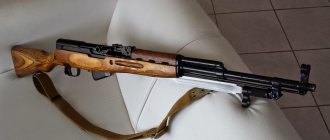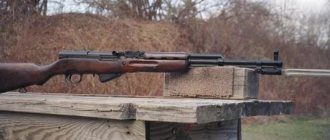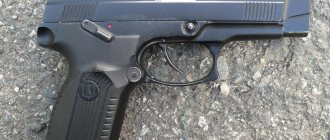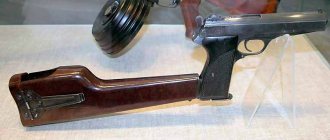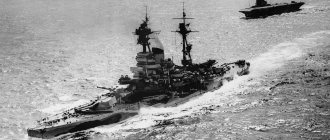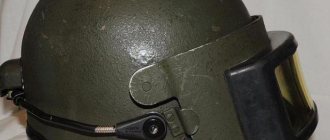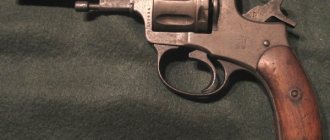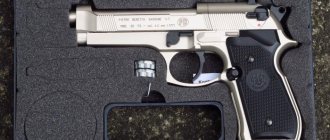Despite all the strengths of the TT pistol, this model has one drawback. It consists in the presence of delays during shooting. The reason for this was the tendency for its parts to freeze at a temperature of -30 degrees. The imperfection of the TT became obvious during the blockade winter. Since the servicemen of the Baltic Fleet needed trouble-free and reliable firearms, the designers began work on the production of such a model. The harsh winter was the impetus for the creation of the Baltiets pistol.
The beginning of the creation of the Baltiets pistol (USSR, Leningrad)
Especially many complaints about the freezing of parts in the standard TT were received by higher authorities from the military command of the Baltic Fleet. At the request of Rear Admiral Yu. F. Rall, the design of a weapon equipped with more reliable automation than in the TT began.
The “Baltiets” pistol was produced in besieged Leningrad at Priboro-Machine-Building Plant No. 181. Responsibility for the quality of the weapon was assigned to the director of the enterprise, B.P. Rumyantsev. The design was carried out under the leadership of chief designer Egorov and factory technologist F.A. Bogdanov. The Walther PP was taken as the basis for the Baltiets pistol. The gunsmiths had to convert it to the standard 7.62 x 25 mm Red Army ammunition used in the Tokarev pistol. A sketch was made for the future small arms, which was approved by the head of the workshop A.I. Balashov. In the first batch it was planned to produce 15 units. Work on the production of the Baltiets pistol was carried out at the milling, turning and metalworking sections of the factory. The manufacture of parts did not require the use of pre-prepared equipment. At the end, the weapon parts were subjected to a bluing procedure, which was carried out in an artisanal way.
Creator Diaries
The fate of the creators of “Baltiyets” remains unknown. In particular, the rumor that they were repressed has not been dispelled. Some - for the loss of parts during the production of a pistol, and others - after the war, as part of the so-called “Leningrad case”, when many city leaders were shot. There is an opinion that the country's top leadership could regard the production of "Baltiyets" as dangerous self-will.
A kind of confirmation of this version can be the diary of an employee of plant No. 181, Yuri Fokin. He was the head of the workshop where parts for experimental models of a unique pistol were made. The diary also talks about how important details disappeared during work on “The Baltic” and they allegedly tried to blame Yuri Vladimirovich for their disappearance. In this notebook, Fokin mentioned that the employees of his workshop produced several types of weapons, which were then handed over to the city leadership - in this case we are talking specifically about the “Baltiyets”.
Baltic
Pistol "Baltiets"
Photo: IZVESTIA/Zurab Javakhadze
The version about the German prototype of the Leningrad pistol is proven by a recording made by the head of the workshop on December 2, 1942. “Today the bolt from the secret weapon “Walter” disappeared on my site. For this loss, I was dragged to all departments several times, I wrote explanatory notes, and copied reports. I feel that all these troubles greatly affect my health. Pavlusha Gavrilov worries about this loss no less than I do,” wrote Yuri Fokin.
Description of specimen No. 1
On the handle of the main model of the Baltiets pistol (a photo of the weapon is presented in the article) there is an engraved circle, inside of which an anchor is depicted. At the bottom of the handle there is a place for a five-pointed star, a sickle, a hammer and the inscription “Plant No. 181”. One side of the pistol is equipped with the inscription “P. A. Baltiets”, and the opposite - “Secretary of the Central Committee of the All-Union Communist Party of Bolsheviks, Member of the Military Council of the Lening Front, T. A. A. Zhdanov.” The right side of the bolt housing became the location of two engraved anchors and the number “181”.
For senior command staff
Three surviving copies of the Baltiets pistol, manufactured in the besieged city, are kept in the Central Naval Museum of St. Petersburg.
“The first one belonged to Rear Admiral Nikolai Smirnov,” says Boris Smirnov, head of the museum’s weapons collection. — The second “Baltiets” was in the use of the Secretary of the Central Committee of the All-Union Communist Party of Bolsheviks, member of the Military Council of the Leningrad Front Andrei Zhdanov — there is a personal etched inscription on the pistol body. And the third pistol is the personal weapon of Nikolai Kuznetsov, People's Commissar of the Navy.
According to the main version, the development of the Baltiyets began when significant shortcomings of the main Soviet pistol, the TT, were identified.
“The fact is that during severe frosts, at -20 and below, the TT did not fulfill its main function - it was impossible to shoot from it,” historian and veteran of the naval museum Igor Sukhanov told Izvestia. — Plant No. 181, subordinate to the People's Commissariat of Shipbuilding, was given the task to design and manufacture a pistol that would not have such shortcomings and would be more reliable in combat conditions in the north.
Baltic
Pistol "Baltiets"
Photo: IZVESTIA/Zurab Javakhadze
However, representatives of the former plant No. 181, which today is called “Engine,” told Izvestia that no one has seen the relevant orders of the People’s Commissariat and where they are stored is unknown.
According to some experts, the German Wahlter PP was taken as the basis for the new pistol. But the Leningrad developers did not completely copy the German prototype - the Baltiets came out somewhat larger.
“The pistol is adapted for the TT cartridge, manufactured at the 181st plant in 1942 in Leningrad during the blockade by the Nazi invaders and is an example of the ability of Leningrad workers, in conditions of blockade and hunger, to produce weapons to defeat the enemy” - this record accompanies those stored in the Central samples of the "Baltiyets" at the naval museum.
Before presenting the “Baltiyets” to high-ranking officers, the new weapon passed all the necessary tests - no one had any doubts about its reliability. However, the pistol was never put into mass production. What caused the project to be abandoned is still not known for certain.
TTX
The Baltiets pistol has the following tactical and technical characteristics:
- By type, this weapon belongs to self-loading pistols.
- Country of origin: USSR.
- "Baltiets" was produced from March to April 1942.
- Manufacturer – No. 181.
- The barrel channel is equipped with four rifling.
- The pistol is equipped with a mainspring with 17 turns.
- The weapon is equipped with standard 7.62 mm Tokarev pistol cartridges.
- The barrel length is 129 mm.
- The pistol weighs 1100 g with an empty magazine.
- It works on the free shutter principle.
- It has an aiming range of up to 50 m.
- The pistol magazine holds 8 rounds of ammunition.
About the second weapon model
The first model pistol was characterized by a design flaw: the weapon had a large mass. In this regard, the basic model needed to be refined. As a result, the second version of the Baltiets pistol was created. The design features of this instance are as follows:
- Unlike the first sample, the weapon weighs no more than 960 g.
- The barrel length was reduced from 12.9 cm to 12 cm.
- There are 15 turns for the mainspring.
After testing, it turned out that the combat parameters of the second copy were no worse than those of pistol No. 1. The presence of high technical characteristics and low weight became the basis for using the second model as a sample in the further production of the pistol.
Nuances
- Weapons designers noticed that when the barrels were folded back, many “fractures” had their walls deformed. This happened especially often in cases where soldering was not used to connect them. These deformations were caused by the fact that when the barrels were folded back, friction occurred between the forend hinge and the moving parts of the gun, absorbing all the energy. In order to prevent deformation of the barrel walls, weapons designers equipped the IZH-56 receivers with special stops in the form of stops. As a result, when tilting the barrels, it was possible to reduce the load on the forend hinge and the hinge post.
- Unlike other “fractures”, in the IZH-56 you can remove the forend with a hinge by performing translational upward movements with open barrels.
- The barrel coupling in the open position is equipped with additional stops. When closing the forend, these stops cover the front cylindrical surface in the hinge, thereby eliminating the rolling of the barrels.
- Unlike other side flints, equipped with additional trunnions for rotating the barrels, the IZH-56 managed to simplify the design. The barrels now rotate only around one hinge bolt.
- If the gun is loaded and its barrels are locked, the hammer is set to the safety cock. This eliminates any interaction with the firing pins and the switch, making accidental shots from the IZH-56 completely impossible.
- The weapon system was adapted to automatically set the trigger to the safety cock. Thanks to this, the owner of the gun was protected from accidental shots, even in situations where the weapon with the hammer already cocked suddenly fell to the ground, or the hammer accidentally came off the cock. If the IZH-56 gun remains not completely locked (the lever has not completely entered the groove), then the hammer is not cocked. When the hammer is cocked, the gun does not open. The trigger itself on the safety cock is installed due to the automatic release. In order to open the gun, the owner must move the locking lever up to the limit.
- The latch for the handguard in the IZH-56 is the same as in the IZH-54 and IZH-K. However, for the Belka, the designers borrowed 40% of spare parts from other models of small arms, having previously tested them for strength. The use of technology for such parts greatly facilitated the work of weapons designers when it was necessary to repair or replace parts in the IZH-56.
- Using the switch, the shooter adjusts the gun barrel he needs. Judging by the reviews of many IZH-56 owners, the fire selector, which is a switch, is often associated with a fuse. But as experienced hunters testify, you can soon adapt to this nuance.
About the design
The second version of the small arms consists of a pistol frame to which the barrel, bolt and trigger mechanism are attached. The barrel channel is equipped with four rifling. The pistol is equipped with a safety catch. Combat and recoil springs were developed specifically for the trigger. The location of the latter was a pistol barrel fixedly attached to the frame.
The weapon operates on the free-breech principle. The trigger here is trigger type and double action. The model is fed from a box-shaped pistol magazine. The ammunition in it is arranged in one row. The upper part of the handle is equipped with a special button, with which the magazine is latched into the pistol. The Baltiets is equipped with a front sight and rear sight, which are used as sighting devices. The front sight is part of the bolt casing. The rear sight is adjustable: if necessary, it is possible to make lateral adjustments to its design. The rear sight is installed in a special groove called “dovetail”. The pistol is contained in a wooden case, which is lined with cloth on the inside. On the outside of this case there is a brass plate with the inscription “To Admiral Kuznetsov Nikolai Gerasimovich.”
How does the gun work?
IZH-56 have only one trigger and trigger. The receiver contains a special vertical groove in which the trigger switch is located. It operates under the influence of an intermediate rod, which is activated by a button located in the rear part of the receiver. It is locked in the extreme position by a locking pin. In order to move the button, the arrow must first be pressed on the pin.
In the forward position of the button, the trigger interacts with the upper striker, and in the rear position, with the lower one. This button, in addition to switching the trigger, also affects the rotating rear sight - adjusts its position. In order for the owner of the IZH-56 to have the opportunity to perform zeroing independently, the weapon designers decided to install the rear sight on a special base adapted for lateral movement. For this purpose, the weapon is equipped with a special groove. The location of the mechanism responsible for moving the rear sight was the inside of the receiver.
About the advantages
The Baltiets pistol has the following strengths:
- Simple automation design.
- Reliable to use.
- The pistol is equipped with a very comfortable grip, which has a positive effect on combat accuracy.
- The weapon is always ready for use. This is possible due to the introduction of a double-action trigger.
- "Baltiets" is equipped with a reliable fuse. It is safe to carry such a weapon even with the trigger pulled and ammunition in the chamber, which is not recommended to do with a Tokarev pistol.
About the disadvantages
The disadvantage of the Baltiyets was that it was too heavy. Compared to the Tokarev pistol, whose mass was 825 g, the Baltiets weighed 960 g. In addition, this model was distinguished by its large dimensions. This drawback was due to the fact that the pistol used a 7.62 mm cartridge. This caliber was originally developed for weapons equipped with a short-stroke barrel. Since the Leningrad rifle model was equipped with a blowback automatic, firing such ammunition would have been disastrous for the pistol. For this reason, the designers decided to make the bolt casing heavier.
About spring-compression weapons
In 1974, at the Central Design and Technology Bureau (TsKTB), under the leadership of chief designer Viktor Khristich, work began on creating a wind version of the Baltiets pistol. The pneumatic model was ready three years later. In 1977, blowguns were successfully tested. The place where the pistol was tested was the State Testing Station at the Central Research Institute of Tochmash. The pneumatic model is listed as "Baltiets No. 77".
9 thousand rubles were spent on the production of the blowgun. Since this model was intended for training, the design of the pistol was carried out taking into account the ergonomic characteristics of teenagers. The designers were required to select the optimal weight and size for model No. 77. As a result, a reliable, easy-to-use, safe-to-handle training pneumatic weapon was created.
The fate of the “Baltiets” pistol today
Little is known about this pistol, or more precisely, its original version, since production lasted only a month. During this time, only 15 products were produced. The number of Baltiets produced was too small. In addition, difficult working conditions and the acute crisis situation in the country as a result of the war played a negative role.
"Baltiets" remains an example of what an ideal weapon should be. It survived various loads and severe Baltic frosts.
The remaining copies of the products were made as gifts. They were solemnly presented to senior generals for their military merits.
Description of the wind variant
"Baltiets No. 77" is a spring-compression pneumatic pistol. The air in it is compressed using a special piston with a short stroke (60 mm), which, in turn, is driven by a pre-compressed spring. The piston diameter is 20 mm. In their pistol, Soviet designers used a “reverse design,” which was patented in 1923 by English gunsmiths D. W. Johnson and J. W. Fearnon. The principle of the scheme is that the piston and bullet are provided in opposite directions.
Glass-filled plastic was used in the production of handles, receiver blocks, triggers and rear sights. These parts were made by injection molding. The pneumatic gun is equipped with an open sight. The rear sight of the weapon is adjustable. This gives the shooter the opportunity to customize it for himself while zeroing. The cylindrical surface of the rear sight is equipped with vertical and horizontal marks, with the help of which the displacement value is calculated for it. Once the rear sight is moved to the desired position, it is secured using a locking screw. Caring for your blowgun involves periodic cleaning. This procedure is recommended to be carried out after every two thousand shots. To do this, the owner of the pneumatic gun just needs to lubricate the barrel channel and the internal cylindrical surface of the compressor with gun oil.
About the design features of the pneumatic
“Baltiets No. 77” differs from other models of wind pistols by the presence of a special addition: after pressing the barrel latch located on the left side of the pneumatic gun, the barrel moves forward independently by 1 cm. Only after this can it be turned up. This displacement makes it possible to force the bullet into the barrel rifling. This eliminates additional energy consumption when deforming the bullet during rifling acceleration. As a result, the projectile maintains a high initial velocity and completely eliminates “missing”. The bullet speed is 130 m/s. Since the weapon is loaded with the barrel tilted to the top position, in order to prevent injury to the shooter, the pneumatic gun is equipped with an automatic barrel lock. Thus, in order to fire a shot, it is necessary to return the barrel to its previous position and secure it using a latch.
Developments
In the manufacture of barrels for the IZH-56, the developers used 50A steel. It had a fluidity of at least 50 and a strength of 75 kg/m2. In order for the barrels along their entire length not to lose the high performance of this steel, they were made by drilling with further heat treatment.
In Kazansky's small arms, soldering was used to connect with brass. In IZH-56 shotguns, equipped with hardened barrels, such technology was impossible. Therefore, the barrels were attached to the couplings, swivel and forend post using a press fit. In addition, the barrels were equipped with smooth pins, which protected them from possible displacement during planting. In 1956, the arms factory produced 32 mm upper barrels using a cylindrical pressure drill and having a Paradox choke. Thanks to this type of narrowing, the IZH-56 guns showed good results when firing a bullet during testing. However, the use of an unrifled barrel showed the opposite effect. It was noticed that from a distance of 35 meters, not the entire shot charge hit a target with a diameter of 75 cm, but only 35%. Unrifled barrels of the same IZH-56, not equipped with Paradox constrictions, gave the best results during testing: 45% of the shot hit the 75 cm target. This stimulated designers to create a new choke constriction that would not affect the accuracy of the shot charge.

